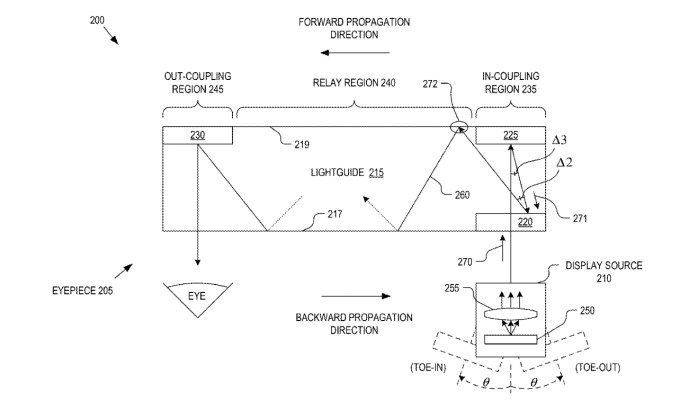October 4, 2015 weblog
Google patent application is about head display with holograms

Might capabilities for augmented reality holograms become a feature of Google smart eyewear? Google filed a patent application involving holograms.
The patent heading in the application is "Lightguide with multiple in-coupling holograms for head wearable display." The two named inventors are Evan Richards and John Perreault. The application was first filed in March 2014.
The patent application said:
"An optical apparatus for a head wearable display includes a lightguide, in-coupling holograms, and an out-coupling optical element. The lightguide includes an in-coupling region for receiving display light into the lightguide, an out-coupling region for emitting the display light out of the lightguide, and a relay region for guiding a path of the display light from the in-coupling region to the out-coupling region. A first of the in-coupling holograms is disposed at the in-coupling region to redirect the path of the display light by a first angle. A second of the in-coupling holograms is disposed across from the first in-coupling hologram at the in-coupling region to redirect the path of the display light by a second angle such that the path of the display light enters a total internal reflection condition in the relay region after redirection by the first and second in-coupling holograms."
Observers said this could be related to a hardware platform for Magic Leap's Augmented reality content. "The patent contextualizes Google Inc leading the $542 million funding round for augmented reality startup Magic Leap," said Josh Constine in TechCrunch.
The technology discussed in the patent application would superimpose computer-generated images on top of the wearer's real world view.
"The patent enables Google to create a headset that would project computer-generated imagery over the real world," said Jon Mundy on Friday in TrustedReviews, "not entirely dissimilar to Microsoft's HoloLens."
The patent application reads: "Single eye displays are referred to as monocular HMDs while dual eye displays are referred to as binocular HMDs. Some HMDs display only a computer generated image ('CGI'), while other types of HMDs are capable of superimposing CGI over a real-world view. This latter type of HMD typically includes some form of see-through eyepiece and can serve as the hardware platform for realizing augmented reality. With augmented reality the viewer's image of the world is augmented with an overlaying CGI, also referred to as a heads-up display ('HUD'). "
Are we to see the holographic capabilities imbued with Google eyewear any time soon? Constine in TechCrunch turned to asking Google. "When I asked about the patent and its significance, I received this boilerplate no-comment response from Google: 'We hold patents on a variety of ideas – some of those ideas later mature into real products or services, some don't. Prospective product announcements should not necessarily be inferred from our patents.'"
While the published patent application might not turn into product news in the future, the patent talk nonetheless turned tech watchers toward thinking there might be plans to do something of this nature with its eyewear concept. Never say never on paths which Google eyewear might eventually take.
Rachel Metz said last year in MIT Technology Review that "The idea that Glass represents—allowing you to ingest digital information at a glance—remains powerful. Even though I gave up on wearing Google Glass pretty quickly, I did find it helpful in situations where I wanted to be online yet didn't want to be interrupted." She further remarked that "A display in your line of sight can make for a better navigational tool or real-time language-translation assistant than a smartphone."
Google said in January, "we're closing the Explorer Program so we can focus on what's coming next. January 19 will be the last day to get the Glass Explorer Edition. In the meantime, we're continuing to build for the future, and you'll start to see future versions of Glass when they're ready. (For now, no peeking.)"
The team behind Google Glass is now known as 'Project Aura' said The Verge in September.
The Wall Street Journal in September said Aura was working on "the next incarnation of Glass." Alistair Barr in The Wall Street Journal said, "Google is quietly distributing a new version of Glass to companies in industries such as health care, manufacturing and energy. Another consumer version is at least a year away and the new Aura team could take the technology in new directions."
More information: Patent: Lightguide With Multiple In-Coupling Holograms For Head Wearable Display
© 2015 Tech Xplore



















